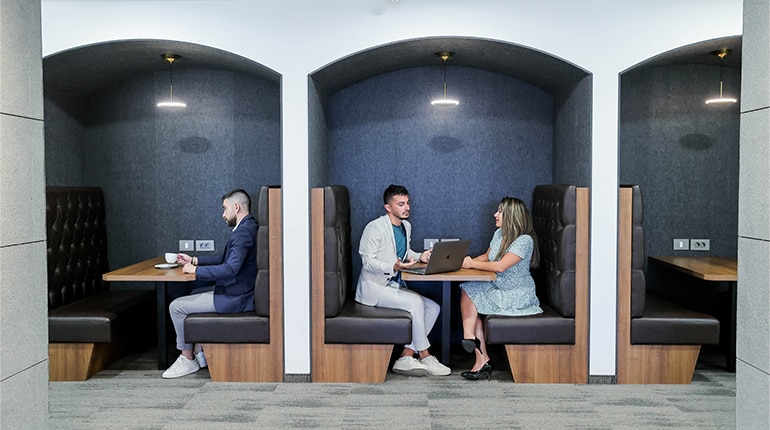Coworking spaces have become a go-to solution for professionals seeking flexibility, community, and modern work environments. As they continue to rise in popularity, they are transforming how people work across industries, roles, and regions.
Despite its popularity, coworking myths still linger. These misconceptions can deter professionals and established businesses from exploring spaces that might better fit their needs than a traditional office space.
To provide a clearer picture of what coworking actually offers, let’s explore and debunk the most common misconceptions about coworking facilities. Understanding the truth can help your business make informed decisions about embracing these modern work environments.
Myth 1: Coworking Spaces Are Only for Freelancers and Startups
Coworking’s roots may lie in serving freelancers and early-stage startups, but today’s spaces are home to far more. Coworking spaces cater to everyone from remote employees and project consultants to creative agencies and full-time corporate teams.
Walk into a coworking hub and you’ll likely find software developers, marketing directors, legal professionals, and designers all working under one roof. This diversity is part of what makes these spaces so dynamic and inspiring.
Flexible membership options, varied layouts, and on-demand resources make coworking attractive to professionals who want structure without being tied down by long-term commitments. From creative agencies to regional outposts for large firms, coworking continues to redefine how people and companies approach workspace.
Myth 2: Coworking Spaces Lack Privacy
Privacy remains one of the most misunderstood aspects of coworking. While open layouts exist, most coworking spaces also include enclosed offices, soundproof call booths, and private meeting rooms – ensuring confidentiality and privacy when necessary.
Whether you’re meeting with a client, having a team check-in, or just need to think without interruption, there’s a spot in most spaces built exactly for that. It’s this ability to balance openness with privacy that makes coworking so effective.
Myth 3: Coworking Spaces Are Noisy and Distracting
Another of the more common coworking myths is that these spaces are full of distractions. It’s easy to imagine a coworking space as a bustling, loud place. But well-designed coworking environments carefully balance energy with focus.
Quiet work areas, acoustic panels, and reserved desks help reduce distractions. At the same time, open lounges and social zones allow for interaction when desired.
Making coworking spaces adaptable is key to their appeal. Need silence for a writing sprint? Choose a heads-down area. Planning a brainstorm with your team? Head to a shared lounge. With intentional layout and noise management, coworking creates an atmosphere that supports both solo focus and group creativity.
Myth 4: Coworking Spaces Are Expensive
When comparing coworking memberships to traditional office leases, coworking often provides better value. Costs like utilities, Wi-Fi, printing, furniture, and cleaning are included in the monthly fee.
There’s no need to purchase equipment or pay separate bills. Members also avoid long-term commitments, security deposits, and other upfront costs typically required for conventional offices.
This bundled structure can result in real cost savings, especially for small teams or independent professionals. Many providers also offer flexible plans for part-time use or daily access.
For those who want professional space without the financial burden of managing their own office, coworking also eliminates long-term commitments. You pay for the space you need, when you need it, with the ability to scale up or down.
Myth 5: Coworking Spaces Are Unprofessional
Another coworking myth is how coworking spaces offer too casual or informal environments, lacking the polish of a corporate setting. In reality, many coworking spaces are modern, clean, and designed for professionalism.
Features like reception desks, mail handling, business support, and premium meeting rooms are standard in many locations. Spaces are often equipped with presentation tools, projectors, whiteboards, and booking systems.
The sense of professionalism also stems from both the in-house staff and the local clientele. As you’re working alongside motivated peers in a clean, structured, and high-performing setting, you’ll soon find yourself exuding the same sense of professionalism.
Myth 6: Coworking Spaces Are Only in Urban Areas
Coworking providers were once concentrated in big cities like New York, London, or Sydney, but the landscape is quickly expanding. More providers are opening locations in suburban and second-city areas to meet the growing demand for local flexible workspaces.
This shift makes it easier for people to avoid long commutes to the CBD while still enjoying a structured, productive workday. Providers are responding by opening locations outside dense business districts and inside residential areas.
Myth 7: Coworking Spaces Are Just Like Coffee Shops
While both coffee shops and coworking spaces offer flexible seating and community vibes, they serve very different purposes.
While coffee shops prioritize food and ambiance, the necessary amenities may not be as reliable. Coworking spaces, by contrast prioritize seamless productivity. Those working on coworking spaces usually have access to high-speed Wi-Fi, power outlets, comfortable desks, and business services. What’s more, the noise level is better managed, seating is designed for long hours, and security and privacy are built in.
Unlike coffee shops, coworking environments are staffed and structured to support work. Members don’t have to worry about saving a seat, charging a device, or being interrupted.
Myth 8: Coworking Spaces Are Only for Extroverts
The idea that coworking only suits outgoing personalities overlooks the variety these spaces offer. Whether you’re an introvert, extrovert, or somewhere in between, coworking can work for you. Quiet areas, private rooms, and desk dividers allow for personal focus. You can engage with others as much or as little as you like.
Events and social gatherings are available, not mandatory. This makes coworking ideal for people who enjoy having access to a community but also value their alone time.
Myth 9: Coworking Spaces Are a Passing Trend
Coworking is most definitely not a short-term phenomenon. Their advent is a response to deep changes in how people want to work. Flexibility, autonomy, and community have become workplace priorities across industries.
Large enterprises and established businesses now use coworking to support distributed teams, pop-up projects, or global expansion. Coworking gives them the agility they need without being tied to a single location.
The rise in remote work, combined with the desire for better work-life balance and meaningful community, is making coworking spaces a long-term solution. As the workplace continues to evolve, coworking will remain at the forefront of that shift.
Embracing the Future of Coworking
Coworking spaces have grown into flexible, professional environments designed to support a wide range of professionals. They offer the structure of a traditional office, the flexibility of remote work, and the community of like minded individuals all under one roof.
By understanding what coworking truly offers, professionals and businesses can make confident choices about where and how they work best.
Explore coworking spaces near you and experience the freedom, focus, and connection they provide.
Frequently Asked Questions
Are coworking spaces suitable for large teams?
Yes. Many coworking providers offer custom solutions for teams, including private offices, team pods, and scalable layouts.
Can I host client meetings in a coworking space?
Absolutely. Most spaces include access to professional meeting rooms with whiteboards, screens, and comfortable seating.
Do coworking spaces offer 24/7 access?
Many locations provide round-the-clock access. Check with individual providers to see if they support night or weekend work schedules.
Are coworking spaces secure?
Yes. Coworking spaces use access cards, surveillance systems, and lockers to protect both people and belongings.
Do coworking spaces support work-life balance?
They do. Structured environments reduce home distractions and help professionals separate work from personal time, which improves well being and focus.





